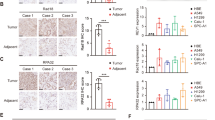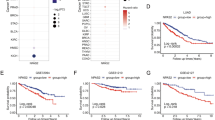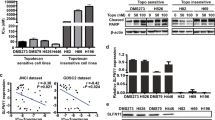Abstract
Lung cancer treatment remains a challenge for clinical practice and new therapeutic approaches are urgently needed. Loss of functional WEE1 kinase causes DNA replication stress, DNA damage and unscheduled mitotic entry due to elevated CDK activity. The selective WEE1 inhibitor MK-1775 synergize with DNA-damaging agent to inhibit cancer cell growth. Here we report that inhibition of Sirt1 deacetylase through small interfering RNA or selective inhibitor Ex527 greatly enhances MK-1775-induced growth inhibition and apoptosis in human lung cancer cells. We further demonstrate that Sirt1 interacts and deacetylates homologous recombination (HR) repair machinery proteins, including NBS1 and Rad51. Inhibition of Sirt1 impairs HR repair activity, which causes unrepairable damage when combining MK-1775 and Ex527. Meanwhile, combination of MK-1775 and Ex527 induces cooperative antitumor activity in lung cancer xenograft model in vivo. Thus, our study provides a novel therapeutic strategy to optimize MK-1775 treatment efficiency in lung cancers.
This is a preview of subscription content, access via your institution
Access options
Subscribe to this journal
Receive 50 print issues and online access
$259.00 per year
only $5.18 per issue
Buy this article
- Purchase on Springer Link
- Instant access to full article PDF
Prices may be subject to local taxes which are calculated during checkout







Similar content being viewed by others
References
Jeggo PA, Pearl LH, Carr AM . DNA repair, genome stability and cancer: a historical perspective. Nat Rev Cancer 2016; 16: 35–42.
Elledge SJ . Cell cycle checkpoints: preventing an identity crisis. Science 1996; 274: 1664–1672.
Malumbres M, Barbacid M . Cell cycle, CDKs and cancer: a changing paradigm. Nat Rev Cancer 2009; 9: 153–166.
O'Connell MJ, Raleigh JM, Verkade HM, Nurse P . Chk1 is a wee1 kinase in the G2 DNA damage checkpoint inhibiting cdc2 by Y15 phosphorylation. EMBO J 1997; 16: 545–554.
Aarts M, Sharpe R, Garcia-Murillas I, Gevensleben H, Hurd MS, Shumway SD et al. Forced mitotic entry of S-phase cells as a therapeutic strategy induced by inhibition of WEE1. Cancer Discov 2012; 2: 524–539.
Beck H, Nahse V, Larsen MS, Groth P, Clancy T, Lees M et al. Regulators of cyclin-dependent kinases are crucial for maintaining genome integrity in S phase. J Cell Biol 2010; 188: 629–638.
Vassilopoulos A, Tominaga Y, Kim HS, Lahusen T, Li B, Yu H et al. WEE1 murine deficiency induces hyper-activation of APC/C and results in genomic instability and carcinogenesis. Oncogene 2015; 34: 3023–3035.
Iorns E, Lord CJ, Grigoriadis A, McDonald S, Fenwick K, Mackay A et al. Integrated functional, gene expression and genomic analysis for the identification of cancer targets. PLoS One 2009; 4: e5120.
Magnussen GI, Holm R, Emilsen E, Rosnes AK, Slipicevic A, Florenes VA . High expression of Wee1 is associated with poor disease-free survival in malignant melanoma: potential for targeted therapy. PLoS One 2012; 7: e38254.
Mir SE, De Witt Hamer PC, Krawczyk PM, Balaj L, Claes A, Niers JM et al. In silico analysis of kinase expression identifies WEE1 as a gatekeeper against mitotic catastrophe in glioblastoma. Cancer Cell 2010; 18: 244–257.
De Witt Hamer PC, Mir SE, Noske D, Van Noorden CJ, Wurdinger T . WEE1 kinase targeting combined with DNA-damaging cancer therapy catalyzes mitotic catastrophe. Clin Cancer Res 2011; 17: 4200–4207.
Hirai H, Iwasawa Y, Okada M, Arai T, Nishibata T, Kobayashi M et al. Small-molecule inhibition of Wee1 kinase by MK-1775 selectively sensitizes p53-deficient tumor cells to DNA-damaging agents. Mol Cancer Ther 2009; 8: 2992–3000.
Osman AA, Monroe MM, Ortega Alves MV, Patel AA, Katsonis P, Fitzgerald AL et al. Wee-1 kinase inhibition overcomes cisplatin resistance associated with high-risk TP53 mutations in head and neck cancer through mitotic arrest followed by senescence. Mol Cancer Ther 2015; 14: 608–619.
Carrassa L, Chila R, Lupi M, Ricci F, Celenza C, Mazzoletti M et al. Combined inhibition of Chk1 and Wee1: in vitro synergistic effect translates to tumor growth inhibition in vivo. Cell Cycle 2012; 11: 2507–2517.
Pfister SX, Markkanen E, Jiang Y, Sarkar S, Woodcock M, Orlando G et al. Inhibiting WEE1 selectively kills histone H3K36me3-deficient cancers by dNTP starvation. Cancer Cell 2015; 28: 557–568.
Wang G, Niu X, Zhang W, Caldwell JT, Edwards H, Chen W et al. Synergistic antitumor interactions between MK-1775 and panobinostat in preclinical models of pancreatic cancer. Cancer Lett 2015; 356 (2 Pt B): 656–668.
Do K, Wilsker D, Ji J, Zlott J, Freshwater T, Kinders RJ et al. Phase I study of single-agent AZD1775 (MK-1775), a Wee1 kinase inhibitor, in patients with refractory solid tumors. J Clin Oncol 2015; 33: 3409–3415.
Leijen S, van Geel RM, Pavlick AC, Tibes R, Rosen L, Razak AR et al. Phase I study evaluating WEE1 inhibitor AZD1775 as monotherapy and in combination with gemcitabine, cisplatin, or carboplatin in patients with advanced solid tumors. J Clin Oncol 2016; 34: 4371–4380.
Choudhary C, Kumar C, Gnad F, Nielsen ML, Rehman M, Walther TC et al. Lysine acetylation targets protein complexes and co-regulates major cellular functions. Science 2009; 325: 834–840.
Masumoto H, Hawke D, Kobayashi R, Verreault A . A role for cell-cycle-regulated histone H3 lysine 56 acetylation in the DNA damage response. Nature 2005; 436: 294–298.
Zhao S, Xu W, Jiang W, Yu W, Lin Y, Zhang T et al. Regulation of cellular metabolism by protein lysine acetylation. Science 2010; 327: 1000–1004.
North BJ, Marshall BL, Borra MT, Denu JM, Verdin E . The human Sir2 ortholog, SIRT2, is an NAD+-dependent tubulin deacetylase. Mol Cell 2003; 11: 437–444.
McCord RA, Michishita E, Hong T, Berber E, Boxer LD, Kusumoto R et al. SIRT6 stabilizes DNA-dependent protein kinase at chromatin for DNA double-strand break repair. Aging 2009; 1: 109–121.
Wang RH, Sengupta K, Li C, Kim HS, Cao L, Xiao C et al. Impaired DNA damage response, genome instability, and tumorigenesis in SIRT1 mutant mice. Cancer Cell 2008; 14: 312–323.
Guertin AD, Li J, Liu Y, Hurd MS, Schuller AG, Long B et al. Preclinical evaluation of the WEE1 inhibitor MK-1775 as single-agent anticancer therapy. Mol Cancer Ther 2013; 12: 1442–1452.
Kreahling JM, Gemmer JY, Reed D, Letson D, Bui M, Altiok S . MK1775, a selective Wee1 inhibitor, shows single-agent antitumor activity against sarcoma cells. Mol Cancer Ther 2012; 11: 174–182.
Kreahling JM, Foroutan P, Reed D, Martinez G, Razabdouski T, Bui MM et al. Wee1 inhibition by MK-1775 leads to tumor inhibition and enhances efficacy of gemcitabine in human sarcomas. PLoS One 2013; 8: e57523.
Lazebnik YA, Kaufmann SH, Desnoyers S, Poirier GG, Earnshaw WC . Cleavage of poly(ADP-ribose) polymerase by a proteinase with properties like ICE. Nature 1994; 371: 346–347.
Aarts M, Bajrami I, Herrera-Abreu MT, Elliott R, Brough R, Ashworth A et al. Functional genetic screen identifies increased sensitivity to WEE1 inhibition in cells with defects in Fanconi anemia and HR pathways. Mol Cancer Ther 2015; 14: 865–876.
Chu WK, Payne MJ, Beli P, Hanada K, Choudhary C, Hickson ID . FBH1 influences DNA replication fork stability and homologous recombination through ubiquitylation of RAD51. Nat Commun 2015; 6: 5931.
Tomimatsu N, Mukherjee B, Catherine Hardebeck M, Ilcheva M, Vanessa Camacho C, Louise Harris J et al. Phosphorylation of EXO1 by CDKs 1 and 2 regulates DNA end resection and repair pathway choice. Nat Commun 2014; 5: 3561.
Wang L, Du Y, Lu M, Li T . ASEB: a web server for KAT-specific acetylation site prediction. Nucleic Acids Res 2012; 40 (Web Server issue): W376–W379.
Garon EB, Rizvi NA, Hui R, Leighl N, Balmanoukian AS, Eder JP et al. Pembrolizumab for the treatment of non-small-cell lung cancer. N Engl J Med 2015; 372: 2018–2028.
Jhuraney A, Woods NT, Wright G, Rix L, Kinose F, Kroeger JL et al. PAXIP1 potentiates the combination of WEE1 inhibitor AZD1775 and platinum agents in lung cancer. Mol Cancer Ther 2016; 15: 1669–1681.
Zhou L, Zhang Y, Chen S, Kmieciak M, Leng Y, Lin H et al. A regimen combining the Wee1 inhibitor AZD1775 with HDAC inhibitors targets human acute myeloid leukemia cells harboring various genetic mutations. Leukemia 2015; 29: 807–818.
Mak JP, Man WY, Ma HT, Poon RY . Pharmacological targeting the ATR-CHK1-WEE1 axis involves balancing cell growth stimulation and apoptosis. Oncotarget 2014; 5: 10546–10557.
Chaudhuri L, Vincelette ND, Koh BD, Naylor RM, Flatten KS, Peterson KL et al. CHK1 and WEE1 inhibition combine synergistically to enhance therapeutic efficacy in acute myeloid leukemia ex vivo. Haematologica 2014; 99: 688–696.
Chen G, Wang K, Yang BY, Tang B, Chen JX, Hua ZC . Synergistic antitumor activity of oridonin and arsenic trioxide on hepatocellular carcinoma cells. Int J Oncol 2012; 40: 139–147.
Chen G, Tang B, Yang BY, Chen JX, Zhou JH, Li JH et al. Tumor-targeting Salmonella typhimurium, a natural tool for activation of prodrug 6MePdR and their combination therapy in murine melanoma model. Appl Microbiol Biotechnol 2013; 97: 4393–4401.
Weinstock DM, Nakanishi K, Helgadottir HR, Jasin M . Assaying double-strand break repair pathway choice in mammalian cells using a targeted endonuclease or the RAG recombinase. Methods Enzymol 2006; 409: 524–540.
Acknowledgements
This work was supported by National Natural Science Foundation of China (No. 81772010, 81571721 and 81301214), The National Basic Research and Development Program of China (973 Program; No. 2013CB733803) and Natural Science Basis Research Plan in Shaanxi Province of China (Program No. 2016JM8016 and 2013JQ4040).
Author information
Authors and Affiliations
Corresponding authors
Ethics declarations
Competing interests
The authors declare no conflict of interest.
Additional information
Supplementary Information accompanies this paper on the Oncogene website
Rights and permissions
About this article
Cite this article
Chen, G., Zhang, B., Xu, H. et al. Suppression of Sirt1 sensitizes lung cancer cells to WEE1 inhibitor MK-1775-induced DNA damage and apoptosis. Oncogene 36, 6863–6872 (2017). https://doi.org/10.1038/onc.2017.297
Received:
Revised:
Accepted:
Published:
Issue Date:
DOI: https://doi.org/10.1038/onc.2017.297
This article is cited by
-
SIRT1 ISGylation accelerates tumor progression by unleashing SIRT1 from the inactive state to promote its deacetylase activity
Experimental & Molecular Medicine (2024)
-
Synergistic effect of adavosertib and fimepinostat on acute myeloid leukemia cells by enhancing the induction of DNA damage
Investigational New Drugs (2024)
-
EZH2 as a prognostic-related biomarker in lung adenocarcinoma correlating with cell cycle and immune infiltrates
BMC Bioinformatics (2023)
-
C11orf54 promotes DNA repair via blocking CMA-mediated degradation of HIF1A
Communications Biology (2023)
-
SIRT1 deacetylates WEE1 and sensitizes cancer cells to WEE1 inhibition
Nature Chemical Biology (2023)



